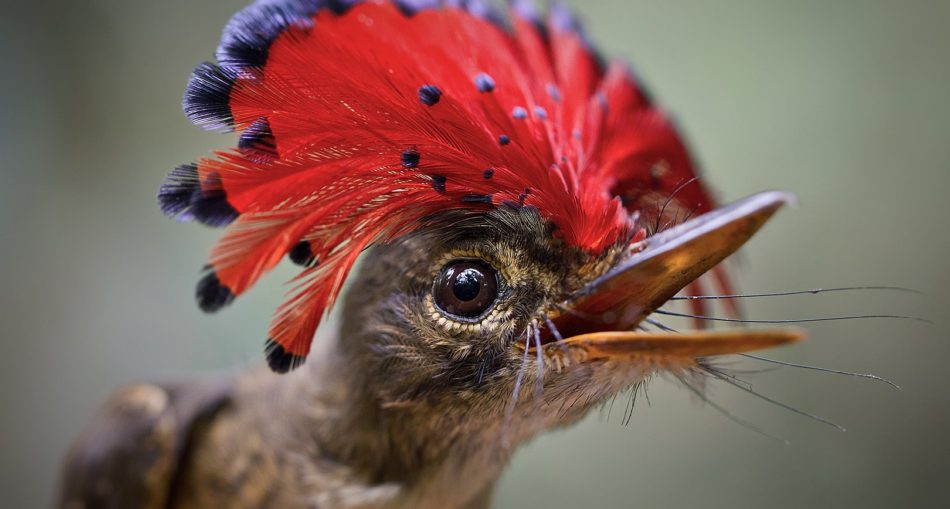The Amazonian royal flycatcher (Onychorhynchus coronatus) is a handsome fellow that is a little bit smaller than a Kiskadee and can be seen in forests throughout the Guiana Shield including the Iwokrama Forest at the Canopy Walkway (Guyana). This tiny bird, growing to all of 15-16 cm, is closely related to the Northern Royal Flycatcher, the Pacific Royal Flycatcher and the Atlantic Royal Flycatcher. It boasts of an impressive crest that it proudly displays on its head. Males have brilliant scarlet crests, while females have crests that are a stunning yellow with black or blue tips. It usually keeps its crest flat on the head and seems like an ordinary little brown bird. But when it does raise its hammer-shaped crest, what a sight it is! It may be difficult to see except when the male erects its majestic crest when alarmed or trying to attract a mate. Scientists refer to the Amazonian Royal Flycatcher as a “passerine” or perching bird. Their prey consists mainly of insects that fly. Their predators are snakes and large birds.
Scientific Classification Of The Amazonian Royal Flycatcher
- Kingdom: Animalia
- Phylum: Chordata
- Class: Aves
- Order: Passeriformes
- Family: Tityridae
- Genus: Onychorhynchus
- Species: O. coronatus
There Are Two Subspecies Of The Amazonian Royal Flycatcher
- c. castelnaui – west Amazonia
- c. coronatus – east Venezuela, the Guianas, and north Brazil
Where Does The Amazonian Royal Flycatcher Live?
The Amazonian Royal Flycatcher is found across almost the entire Amazon basin, in the warm and humid lowland forests and woodlands of Bolivia, Brazil, Colombia, Ecuador, Guyana, Peru, Suriname, and Venezuela, to name a few. The Amazonian Royal Flycatcher breeds in some of the most intact, moister forests on earth.
What Does The Amazonian Royal Flycatcher Look Like?
Relatively small, Amazonian Royal Flycatchers are about six and a half inches (16.5 cm) long with a spectacular, yet rarely seen feathered crest. The bird is characterized by its widely uniform and dull brown upperparts, its rufous rump and beautiful tail. The throat is somehow white, the rest of the underparts beings almost orange. Most of the time, the bird leaves its crest in a flat position. However, when raised, the royal crest shows an interesting combination of black, blue and scarlet colors creating a magnificent reflection of light throughout the bright colors.
Diet Of The Amazonian Royal Flycatcher
They feed mainly on flying insects, such as butterflies, moths, and bugs.
Behavior Of The Amazonian Royal Flycatcher
They are expert hunters. They usually go foraging within the lower layers of vegetation (mainly bushes and shrubs), where they stay low and quiet, perched on a branch, waiting for flying insects to pass by. An Amazonian royal flycatcher unusual adaptations are its nest. The nest helps the bird keep its eggs safe. The Amazonian royal flycatchers use their colorful plumage as a show of display during courtship rituals, after mating, while preening, in competition with other mates over breeding or territory, or while being handled. Amazonian Royal Flycatchers make an unusual nest that helps keep predators away. They are 6 ft long and made near water.
Reproduction Of The Amazonian Royal Flycatcher
The mother flycatcher lays her eggs usually 2, then keep them warm until they hatch (only the female incubates the eggs). The eggs are incubated for 60% of the day. The period of incubation is 22-23 days. The nestlings are brooded and fed only by the female. Once they get older they quickly grow. When they are big enough, they jump out of their nests and teach themselves how to fly. Also, when they become much older, they can get their own food and build their own nests. In most of their breeding seasons, the birds don’t get much farther south than their breeding grounds.
The Amazonian Royal Flycatcher Conservation Status
Unfortunately, today its forest home is under severe threat due to human encroachment and other activities. (We cannot afford to lose this and other beautiful species that are so important in keeping the balance of our planet’s ecosystems).
Watch This: Royal Flycatcher
The Amazonian Royal Flycatcher
This little magnificent bird can be seen in forests throughout the Guiana Shield including the Iwokrama Forest at the Canopy Walkway (Guyana). They are in fact passerine birds descending from the tyrant family. They are, however, closely related to the Northern Royal Flycatcher, the Pacific Royal Flycatcher and the Atlantic Royal Flycatcher. These beautiful birds are about six and a half inches (16.5 cm) long with a spectacular, yet rarely seen feathered crest. They mainly feed on flying insects.
Note:
- Passerines are birds, whose toes are adapted to easily perch on branches and similar structures.
- The part of the name “royal” is in reference to the fantastic feather display on the crown of the animal’s head.
Article References:
- http://planetbirds.blogspot.com/2014/11/amazonian-royal-flycatcher.html
- https://en.wikipedia.org/wiki/Amazonian_royal_flycatcher
- https://www.stabroeknews.com/2014/05/18/features/amazonian-royal-flycatcher/
- https://prezi.com/3h8zdrlvumqs/amazonian-royal-flycatcher/
- http://www.infobarrel.com/Amazonian-Royal-Flycatcher
- Main Image: Picture of the Amazonian Royal Flycatcher (Onychorhynchus coronatus) | By Tom Ambrose – ARCAmazon, CC BY-SA 4.0, https://commons.wikimedia.org/w/index.php?curid=68093644








1 Comment
Pingback: นี่คือ "นกรอยัลฟลายแคชเชอร์"(แอมะซอน) ที่มีหงอนดูเหมือนมงกุฎ